Buchara |
|
|
|
| Übersicht – Contents: | |
Diese Seite ist Teil des Projektes
Buchara |
|
|
|
| Übersicht – Contents: | |
Flaggen – Flags: |
|||||||||
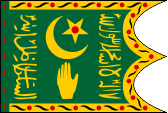 |
19. – 20. Jhd./cent., Flagge des Khan von Buchara – flag of the Khan of Bukhara, Quelle/Source nach/by: Flags of the World |
||||||||
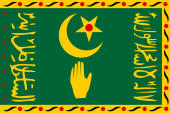 |
Flagge des Khan von Buchara – flag of the Khan of Bukhara, Seitenverhältnis – ratio = 2:3, formotimiert/shape opitmized von/by: Volker Preuss |
||||||||
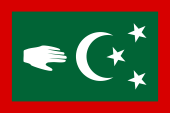 |
19. – 20. Jhd./cent., Flagge Khanat Buchara (?) – flag of the Khanate of Bukhara (?), Quelle/Source nach/by: Flags of the World |
||||||||
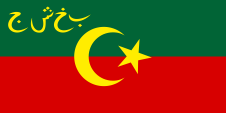 |
1920–1921, Flagge Sozialistische Volksrepublik Buchara – flag of the Soc. People’s Republic of Buchara, Seitenverhältnis – ratio = 2:3, Quelle/Source nach/by: Flags of the World
|
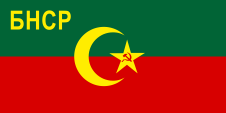
1921–1923, |
Flagge Sozialistische Volksrepublik Buchara – flag of the Soc. People’s Republic of Buchara, Seitenverhältnis – ratio = 2:3, Quelle/Source nach/by: Flags of the World
|
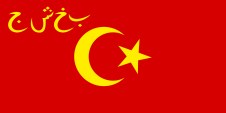
1923–1924, |
Flagge Sozialistische Volksrepublik Buchara – flag of the Soc. People’s Republic of Buchara, Seitenverhältnis – ratio = 1:2, Quelle/Source nach/by: Flags of the World
|
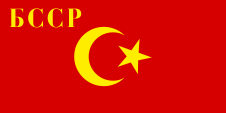
1924–1925, |
Flagge Sozialistische Republik Buchara (?) – flag of the Socialistic Republic of Bukhara (?), Seitenverhältnis – ratio = 1:2, Quelle/Source: keine Quelle mehr zu ermitteln – no source to be determined anymore | ||
| Die Flagge des Khans von Buchara zeigte ein mit einem auffälligen Rand umgebenes grünes Tuch mit goldenem Halbmond und Stern, den Symbolen des Islam, aber auch der Türken, ergänzt um die Hand Fatimas (Glückssymbol), der Tochter des Propheten Mohammed, sowie arabischen Inschriften. | The flag of the Khan of Bukhara showed a with a showy border surrounded green bunting with a golden half-moon and a star, the symbols of Islam but even of the Turks, completed by the hand of Fatima (symbol of luck), the daughter of Prophet Mohammed, as well as arabian inscriptions. |
| Nach dem Ende der Monarchie durch einen kommunistischen Putsch, wurden die arabischen Zeichen und die Hand Fatimas entfernt, die Initialen des Landes wurden in der Oberecke hinzugefügt, und die Hälfte der Flagge musste dem kommunistischen Rot eingeräumt werden. Ab 1923 war sie nur noch einfarbig rot. | After the end of the
monarchy after a communist coup d’état, the arabian signs had been removed as well
as the hand of Fatima, and the initials of the country were added in the upper staff
quadrant, and the half of the flag has to be ceded for the communist red. Since 1923 it
was only single-coloured red. |
| Quelle/Source: Volker Preuss, Flags of the World | |
| Turkistan um 1870 – Turkistan about 1870: |
|
| Quelle/Source: Freeware, University of Texas Libraries, modyfied by: Volker Preuss |
Zahlen und Fakten – Numbers and Facts: |
|
|
|
|
|
|
|
|
|
|
|
|
|
| Quelle/Source: RetroBib Retrobibliothek | |
Geschichte: |
| Antike
· Besiedlung durch iranische Völker 5. Jhd. · Einwanderung von Turkvölkern 8. Jhd. · Islamisierung durch eindringende Araber 714–874 · Teil des Arabischen Kalifats 10.–11. Jhd. · Staat Maverannah (Transoxanien) unter den Samaniden 11. Jhd. · Eroberung durch die Seldschuken 1218–1226 · Eroberung durch die Mongolen unter Dschingis Khan und seinen Nachfolgern 1363 · Ende der Mongolenherrschaft, Invasion des Timur 08.04.1369 · Timur wird Emir von Transoxanien mit Residenz in Samarkand 15. Jhd. · Einwanderung der Usbeken (benannt nach Ösbek Khan, einem Herrscher der Goldenen Horde) unter Abulkhair Khan 1500 · Eroberung durch die Usbeken unter Scheibani Mehemmed Chan, einem Nachfahren Dschingis Khans, Entstehung des Khanats Buchara 1597 · mit dem Tod von Abdullah Khan endet die Herrschaft der Dschingiden 1597–1737 · Dynastie der Aschtarchaniden als usbekische Khane ca. 1710 · der Usbeke Shah-Rukh gründet das Khanat Kokand, durch Abtrennung des Fergana-Tals vom Khanat Buchara 1747–1756 · das Land ist von persischen Truppen besetzt ab 1785 · Dynastie der Mangiten als usbekische Khane (Titel Emir) 1826–1860 · Herrschaft von Nasrullah Bahadir Khan, zahlreiche Kriege gegen Kokand, Chiwa, Persien und Afghanistan 1842 · Eroberung von Kokand 1864–1868 · schrittweise russische Eroberung 30.06.1868 · das Khanat Buchara wird Vasall Russlands, Abtretung von Samarkand an Russland 1917 · Bolschewistischer Putsch in Russland 1917–1918 · Bürgerkrieg März 1918 · Sowjetrussland erkennt das Khanat Buchara an August 1920 · Putsch der Kommunistischen Partei von Buchara, Invasion Sowjetrusslands 02.09.1920 · Eroberung der Stadt Buchara durch die Truppen Sowjetrusslands, der Emir flieht nach Afghanistan, Proklamation der Sowjetrepublik Buchara 18.10.1920 · Proklamation der Sozialistischen Volksrepublik Buchara 1920–1923 · Bürgerkrieg 04.03.1921 · Bündnis mit Sowjetrussland, Sowjetrussland erkennt die Unabhängigkeit Bucharas de facto an, jedoch Verhaftung der gesamten Führung des Landes durch die Kommunisten 19.09.1924 · Proklamation der Sozialistischen Republik Buchara 17.02.1925 · Auflösung der Sozialistischen Republik Buchara, Anschluss an Sowjet-Usbekistan |
History: |
| antiquity
· settlement by Iranian nations 5th century A.D. · immigration of Turk nations 8th century · Arabian conquest, islamization 714–874 · part of the Arabian Califate 10th–11th century · Maverannah State (Transoxania) under the Samanids 11th century · conquest by the Selchuks 1218–1226 · conquest by the Mongols under Dshingis Khan and his successors 1363 · end of the Mongol rule, invasion of Timur 8th of April 1369 · Timur becomes Emir of Transoxania with royal seat in Samarkand 15th century · migration of Uzbeks (named after Ösbek Khan, a ruler of the Golden Horde) under the leadership of Abulkhair Khan 1500 · conquest by the Uzbeks under Sheibani Mehemmed Chan, a descendant of Dshingis Khan, establishment of the Khanate of Buchara 1597 · with the death of Abdullah Chan ends the reign of the Dshingids 1597–1737 · dynasty of the Ashtarkhanids as Uzbek Chans ca. 1710 · the Uzbek Shah-Rukh establishes the Khanate of Kokand by separation of Fergana Valley from the Khanate of Bukhara 1747–1756 · the country is occupied by Persian troops since 1785 · dynasty of the Mangits as Uzbek Chans (title Emir) 1826–1860 · rule of Nasrullah Bahadir Chan, numerous wars against Kokand Khiva, Persia and Afghanistan 1842 · conquest of Kokand 1864–1868 · gradually Russian conquest 30th of June 1868 · the Khanate of Bukhara becomes a vassal of Russia, cede of Samarkand to Russia 1917 · bolshevist coup d’état in Russia 1917–1918 · civil war March 1918 · Soviet Russia recognizes the Khanate of Bukhara August 1920 · coup d’état of the Communist Party of Bukhara, invasion of Soviet Russia 2nd of September 1920 · conquest of Bukhara Town by troops of Soviet Russia, the Emir escapes to Afghanistan, proclamation of the Soviet Republic of Bukhara 18th of October 1920 · proclamation of the Socialistic People’s Republic of Bukhara 1920–1923 · civil war 4th of March 1921 · alliance with Soviet Russia, Soviet Russia recognizes de facto the independence of Bukhara, but apprehension of the whole leadership of the country by the communists 19th of September 1924 · proclamation of the Socialistic Republic of Bukhara 17th of February 1925 · dissolution of the Socialistic Republic of Bukhara, annexion to Soviet Uzbekistan |
| Quelle/Source: RetroBib Retrobibliothek, World Statesmen, Wikipedia (D) |
Ursprung des Landesnamens – Origin of the Country's Name: |
|
| Der Name "Buchara" geht auf eine buddhistische Dynastie des frühen Mittelalters zurück, die der Stadt ihren Namen gab. Er hat altindische Wurzeln und stammt von dem Wort "Bihara" ab, was "Kloster" heißt. | The name "Bukhara" has its roots in a buddhist dynasty of the early middle ages, which gave the town its name. It has ancient indian roots and descends from the word "Bihara" what means "Monastery". |
| Quelle/Source: Handbuch der geographischen Namen | |